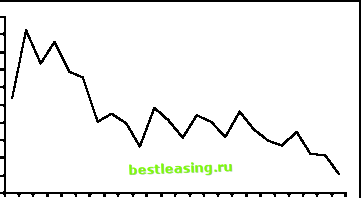

 |
 |

|
Промышленный лизинг
Методички
Risk #1: Rising Interest Rates In June 2003, the interest rate on the 10-year Treasury was 3.11%. One year later, in June 2004, it was 4.82%. This stunning increase of more than 50% in just one year shows how rapidly rates can rise. How far will interest rates rise? What will the effect be on housing prices? First, how far will interest rates rise? We learned two key facts in the discussion on bonds that are worth repeating. First, as compared to the last 20 years, interest rates are extremely low. Second, this is especially true when interest rates are adjusted for inflation. Figure 9.5 shows the real-inflation-adjusted-interest rate on 10-year Treasury bonds. This is calculated by subtracting the inflation rate from the interest rate. Unless the economic world has changed completely, real interest rates will rise. This can occur via a decrease in inflation or an increase in interest rates. If inflation does not fall from current levels, how far will interest rates rise? Over the previous 10 years, the real interest rate (the premium over the inflation rate) has averaged 3.3%. Consumer price 10% 9% 8% 7% 6% 5% 4% 3% 2% 1% 0%  * part of year FIGURE 9.5 Real Interest Rates Are Extremely Low Source: U.S. Federal Reserve, Bureau of Labor Statistics inflation is heating up a bit. The annualized rise so far in 2004 is 3.3%. A different method of estimating inflation that looks at year over year changes in prices registers a slightly more benign 3.1%. Thus, if the real interest rate returns to the average of the previous decade, the interest rate on the 10-year Treasury will rise from 4.8% to somewhere between 6.4% and 6.6%. The interest rate on the 10-year Treasury bond could therefore easily rise to above 6%. In fact, such a rise could be said to restore interest rates to normal levels. The 3.11% rate of June 2003 looks like an irrationally low interest rate, and the subsequent rise a return to a level with more appropriate compensation for inflation. What would the effect of a 6% interest rate rise be on home values? The exact answer is difficult because it relies on so many factors. However, a simple approximation is made by assuming that home buyers will make a mortgage payment that is a fixed percentage of their paycheck. This assumes, for example, that a buyer who can afford a $1,000 monthly $200,000 $180,000 $160,000 $140,000 $120,000 $100,000 $80,000 $60,000 $40,000 $20,000 $0 $179,279 $161,899 5143,298 2003 low current (7/2004) Mortgage rates normal FIGURE 9.6 Rising interest Rates Would Hurt Housing Prices Source: U.S. Federal Reserve mortgage payment today would be willing to make the same payment in a higher interest rate environment. Lets see the effect of interest rates with this assumption and then adjust the answer. The analysis looks at the amount a person can borrow with a 30-year, fixed-rate mortgage and a monthly payment of $1,000. At the low mortgage rates of 2003, this hypothetical buyer could have borrowed $179,000. At the current rate, the figure drops to $162,000, and if real rates return to normal, our buyer could only borrow $143,000 (see Figure 9.6). Thus, for a buyer who allocates a fixed percentage of her or his income to a mortgage payment, a return to historical real interest rates would decrease the feasible home purchase price by 20%. This view suggests that a return to a more normal real interest rate could push home prices down as much as 20%. Of course, the decline could be far less as sellers are reluctant to cut prices even in soft markets, and buyers might be willing to stretch budgets. On the other hand, interest rates could swing from their 2003 irrational low to rates significantly above 6%. Two conclusions seem obvious: Interest rates are historically low by almost any measure, and so rising interest rates are likely; and, they will put downward pressure on housing prices. It is said that the snake that bites is rarely the snake that is visible. Almost everyone is aware of the risks that rising interest rates create for housing prices. By contrarian logic, therefore, rising interest rates are unlikely to topple the housing market. If there is to be a big bad wolf in housing it is likely to come in the form of some less discussed risks. Risk #2: Leverage I first learned about leverage during my high school physics class. My teacher got the biggest, strongest football player in the class to compete against a scrawny boy. The battle was to push a door that was half open; the football player was given the task of trying to close the door, while the scrawny nerd tried to force it open even further. 1 2 3 4 5 6 7 8 9 10 11 12 13 14 15 16 17 18 19 20 21 22 23 24 25 26 27 28 29 30 31 32 33 34 35 36 37 38 39 40 41 42 43 44 45 46 47 48 49 50 51 52 53 54 55 56 57 58 59 60 61 62 63 64 65 66 67 68 69 70 71 [ 72 ] 73 74 75 76 77 78 79 80 81 82 83 84 85 86 87 88 89 90 91 92 93 94 95 96 97 98 99 100 101 102 103 104 105 |